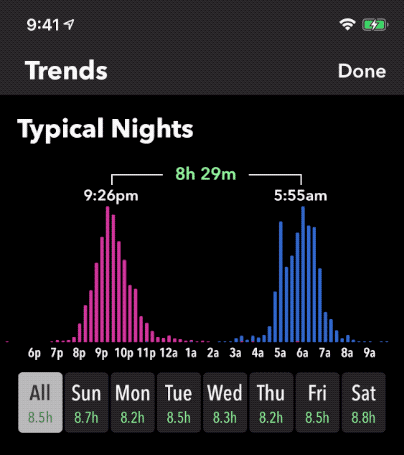This week Apple introduced sleep tracking for the Apple Watch with watchOS 7. This was a day I’ve long expected since I introduced Sleep++ way back in September of 2015 alongside watchOS 2. I wanted to try out Apple’s approach for a few nights before I commented on what impact I think this will have for Sleep++.
In short, I think this will be an overall boost for 3rd-party sleep trackers and lead to a broadening of the Apple Watch sleep tracking ecosystem.
We call it ‘sherlocking’ when Apple takes a feature or capability of a 3rd-party app and elevates it into the main OS. The impact of this can take a wide range of forms. It can be utterly destructive and eliminate the market for the original app, or just as often, it can elevate awareness of the features and be a boon for developers.
Over my more than a decade of being an Apple developer I’ve personally experienced both ends of that spectrum.
For example, when Apple introduced 3rd-party keyboards I created Emoji++. Which provided a more intuitive way of finding emoji. A similar design was later adopted by the iOS keyboard and with it all interest in my app evaporated overnight.
But I’ve also had the opposite experience. When Apple added a motion co-processor with the iPhone 5S they provided no mechanism for reading the data it tracked. So I made Pedometer++ which was the first app to surface this step data to users. A year later Apple introduced the Health app as one of the built-in apps which included step tracking as one of its features. The net result was a dramatic up-tick in Pedometer++ usage and downloads.
What I saw happen with Pedometer++ was that by adding step tracking to the Health app Apple provided the most powerful marketing tool possible. They introduced countless users to the idea that they could use their iPhone to track their steps and that awareness then overflowed into the 3rd-party ecosystem.
So often the biggest challenge I face as an indie developer isn’t just making customers aware of my products, but making them even consider that the capabilities I provide are even things that their iPhone can do. When Apple takes on a feature and makes it a 1st-party experience they also take on the burden of that communication and educating customers about what is possible.
Often the experience Apple provides is tailored to support the widest possible audience, which by definition will work for most customers. However, there will always be customers who want more than a basic experience. Which is where the overflow to 3rd-party developers can begin. I hear countless stories of customers who started off tracking their steps in Health but then later switched to Pedometer++ when they wanted a richer, more powerful experience.
Having spent a while exploring Apple’s sleep tracking design I’m increasingly confident that I’ll see a similar effect this fall.
The biggest challenge I face in marketing Sleep++ is convincing potential customers that sleep tracking is even possible with an Apple Watch. They read an Apple Watch review with a long list of pros, but then always finish with “No Sleep Tracking” in the cons list.
I suspect this fall Apple will heavily market sleep tracking as a feature of the Apple Watch (and if I were to guess introduce a new sensor or capability with the Series 6 watches that makes it even better). Apple’s approach to sleep tracking that they announced this week seems to fall firmly in the “designed for a wide audience” bucket. It is thoughtfully designed and I’m sure their data analysis is first class, but there is only so far they will go.
My goal for Sleep++ is to provide approachable, intuitive display of your sleep patterns to help you make better sleep choices. For example, Sleep++ provides things like this advanced visualization of your typical nightly patterns:

This intuitive display of complex data is the main reason that I hear people like and stick with Sleep++ rather than one of my varied competitors. I believe this approach will continue to provide value moving forward.
If anything Apple providing 1st-party analysis will improve what I can offer by allowing me to leverage their advanced data collection into my own sleep analysis algorithms and improve the accuracy of my data. All the data Apple is collecting is stored in the Health app so I can start pulling it into Sleep++ and boost my own accuracy too.
I suppose a good summary of my expectation is that right now (say) 1% of Apple Watch wearers think to try sleep tracking. After this fall, most Apple Watch wearers will be aware of it and (say) 50% will try it out. Apple’s approach will be sufficient for 90% of them, but 10% will want more. Leading to now 5% of Apple Watch wearers looking for a 3rd-party app to augment their experience…so I end up way ahead overall.
This is entirely speculative and it is possible that the market for Sleep++ will completely evaporate, but I’ve been doing this for long enough and have seen this pattern repeat itself often enough that I really don’t think so.
I suppose you could say I’m not losing sleep over it (sorry I couldn’t resist).